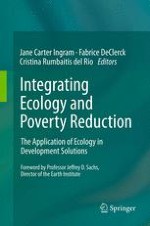2012 | OriginalPaper | Chapter
19. Looking Forward: The Future and Evolving Role of Ecology in Society
Author : Shahid Naeem
Published in: Integrating Ecology and Poverty Reduction
Publisher: Springer New York
Activate our intelligent search to find suitable subject content or patents.
Select sections of text to find matching patents with Artificial Intelligence. powered by
Select sections of text to find additional relevant content using AI-assisted search. powered by
